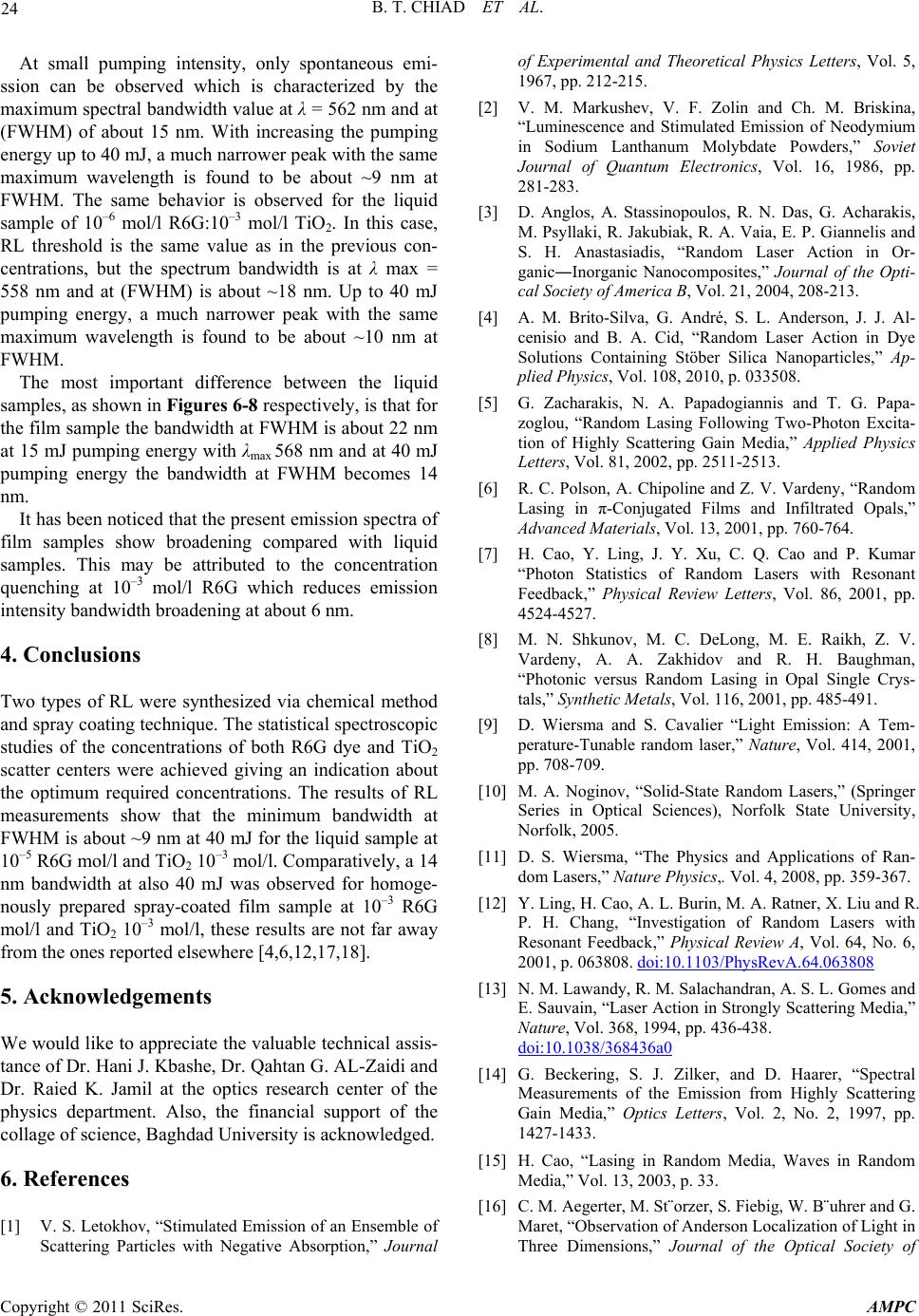
B. T. CHIAD ET AL.
24
At small pumping intensity, only spontaneous emi-
ssion can be observed which is characterized by the
maximum spectral bandwidth value at λ = 562 nm and at
(FWHM) of about 15 nm. With increasing the pumping
energy up to 40 mJ, a much narrower peak with the same
maximum wavelength is found to be about ~9 nm at
FWHM. The same behavior is observed for the liquid
sample of 10–6 mol/l R6G:10–3 mol/l TiO2. In this case,
RL threshold is the same value as in the previous con-
centrations, but the spectrum bandwidth is at λ max =
558 nm and at (FWHM) is about ~18 nm. Up to 40 mJ
pumping energy, a much narrower peak with the same
maximum wavelength is found to be about ~10 nm at
FWHM.
The most important difference between the liquid
samples, as shown in Figures 6-8 respectively, is that for
the film sample the bandwidth at FWHM is about 22 nm
at 15 mJ pumping energy with λmax 568 nm and at 40 mJ
pumping energy the bandwidth at FWHM becomes 14
nm.
It has been noticed that the present emission spectra of
film samples show broadening compared with liquid
samples. This may be attributed to the concentration
quenching at 10–3 mol/l R6G which reduces emission
intensity bandwidth broadening at about 6 nm.
4. Conclusions
Two types of RL were synthesized via chemical method
and spray coating technique. The statistical spectroscopic
studies of the concentrations of both R6G dye and TiO2
scatter centers were achieved giving an indication about
the optimum required concentrations. The results of RL
measurements show that the minimum bandwidth at
FWHM is about ~9 nm at 40 mJ for the liquid sample at
10–5 R6G mol/l and TiO2 10–3 mol/l. Comparatively, a 14
nm bandwidth at also 40 mJ was observed for homoge-
nously prepared spray-coated film sample at 10–3 R6G
mol/l and TiO2 10–3 mol/l, these results are not far away
from the ones reported elsewhere [4,6,12,17,18].
5. Acknowledgements
We would like to appreciate the valuable technical assis-
tance of Dr. Hani J. Kbashe, Dr. Qahtan G. AL-Zaidi and
Dr. Raied K. Jamil at the optics research center of the
physics department. Also, the financial support of the
collage of science, Baghdad University is acknowledged.
6. References
[1] V. S. Letokhov, “Stimulated Emission of an Ensemble of
Scattering Particles with Negative Absorption,” Journal
of Experimental and Theoretical Physics Letters, Vol. 5,
1967, pp. 212-215.
[2] V. M. Markushev, V. F. Zolin and Ch. M. Briskina,
“Luminescence and Stimulated Emission of Neodymium
in Sodium Lanthanum Molybdate Powders,” Soviet
Journal of Quantum Electronics, Vol. 16, 1986, pp.
281-283.
[3] D. Anglos, A. Stassinopoulos, R. N. Das, G. Acharakis,
M. Psyllaki, R. Jakubiak, R. A. Vaia, E. P. Giannelis and
S. H. Anastasiadis, “Random Laser Action in Or-
ganic―Inorganic Nanocomposites,” Journal of the Opti-
cal Society of America B, Vol. 21, 2004, 208-213.
[4] A. M. Brito-Silva, G. André, S. L. Anderson, J. J. Al-
cenisio and B. A. Cid, “Random Laser Action in Dye
Solutions Containing Stöber Silica Nanoparticles,” Ap-
plied Physics, Vol. 108, 2010, p. 033508.
[5] G. Zacharakis, N. A. Papadogiannis and T. G. Papa-
zoglou, “Random Lasing Following Two-Photon Excita-
tion of Highly Scattering Gain Media,” Applied Physics
Letters, Vol. 81, 2002, pp. 2511-2513.
[6] R. C. Polson, A. Chipoline and Z. V. Vardeny, “Random
Lasing in π-Conjugated Films and Infiltrated Opals,”
Advanced Materials, Vol. 13, 2001, pp. 760-764.
[7] H. Cao, Y. Ling, J. Y. Xu, C. Q. Cao and P. Kumar
“Photon Statistics of Random Lasers with Resonant
Feedback,” Physical Review Letters, Vol. 86, 2001, pp.
4524-4527.
[8] M. N. Shkunov, M. C. DeLong, M. E. Raikh, Z. V.
Vardeny, A. A. Zakhidov and R. H. Baughman,
“Photonic versus Random Lasing in Opal Single Crys-
tals,” Synthetic Metals, Vol. 116, 2001, pp. 485-491.
[9] D. Wiersma and S. Cavalier “Light Emission: A Tem-
perature-Tunable random laser,” Nature, Vol. 414, 2001,
pp. 708-709.
[10] M. A. Noginov, “Solid-State Random Lasers,” (Springer
Series in Optical Sciences), Norfolk State University,
Norfolk, 2005.
[11] D. S. Wiersma, “The Physics and Applications of Ran-
dom Lasers,” Nature Physics,. Vol. 4, 2008, pp. 359-367.
[12] Y. Ling, H. Cao, A. L. Burin, M. A. Ratner, X. Liu and R.
P. H. Chang, “Investigation of Random Lasers with
Resonant Feedback,” Physical Review A, Vol. 64, No. 6,
2001, p. 063808. doi:10.1103/PhysRevA.64.063808
[13] N. M. Lawandy, R. M. Salachandran, A. S. L. Gomes and
E. Sauvain, “Laser Action in Strongly Scattering Media,”
Nature, Vol. 368, 1994, pp. 436-438.
doi:10.1038/368436a0
[14] G. Beckering, S. J. Zilker, and D. Haarer, “Spectral
Measurements of the Emission from Highly Scattering
Gain Media,” Optics Letters, Vol. 2, No. 2, 1997, pp.
1427-1433.
[15] H. Cao, “Lasing in Random Media, Waves in Random
Media,” Vol. 13, 2003, p. 33.
[16] C. M. Aegerter, M. St¨orzer, S. Fiebig, W. B¨uhrer and G.
Maret, “Observation of Anderson Localization of Light in
Three Dimensions,” Journal of the Optical Society of
Copyright © 2011 SciRes. AMPC